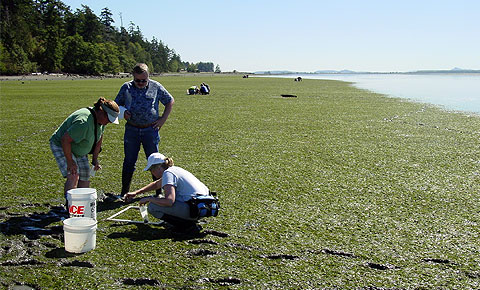|
|
| Click images for enlarged views |
Bellingham Bay, with its abundant fishing grounds and shellfish beds, has been a source of food for local
Native Americans for eons. That is until recently, when Native fishermen began bringing up nets covered in
black mud, and the shellfish beds were closed due to contamination. Dr. Jude Apple began to focus on two
culprits – hypoxia and fecal coliform contamination. "We are investigating basic research questions about
hypoxia in Bellingham Bay," says Jude. "We are looking at low dissolved oxygen and other aspects of water
quality, and how they affect aquatic and natural resources in traditional fishing grounds and tribal waters
near the Lummi Reservation."
In the winter of 2008 Jude worked with the Science Director at
Northwest Indian College (NWIC) on developing a routine
sampling program to investigate hypoxia, wrote a proposal to the United States Department of Agriculture
(USDA) to look at water quality and coastal eutrohication, and was funded for a two-year project to monitor
hypoxia in Bellingham Bay. Jude is quite familiar with hypoxia, having done his PhD research in the
Chesapeake Bay region, so he approached his Bellingham Bay research with some context. Using nine field sites,
he had assumed he would find hypoxia in the deepest part of the bay, as is true in the Chesapeake and the
Gulf of Mexico, but in fact it is in the shallower, northernmost sites where hypoxia is most prevalent,
occurring in July and August.
"I am motivated by these questions: How extensive is hypoxia in Bellingham Bay, what’s driving it, and how can we mitigate its effects?" |
The Bellingham Bay project also supports students as part of a year-round internship program at NWIC – and in
fact could not produce the data needed without the students' participation. (The interns work on independent
research projects that are all related to water quality in Bellingham Bay.) This collaboration has blossomed
into a larger project with interns from NWIC, plus
REU,
PRIME and
MIMSUP students. "It's
something of a hodgepodge," says Jude. "But I'm able to build background and proof of concept data that
allow me to write proposals to continue the larger project."


